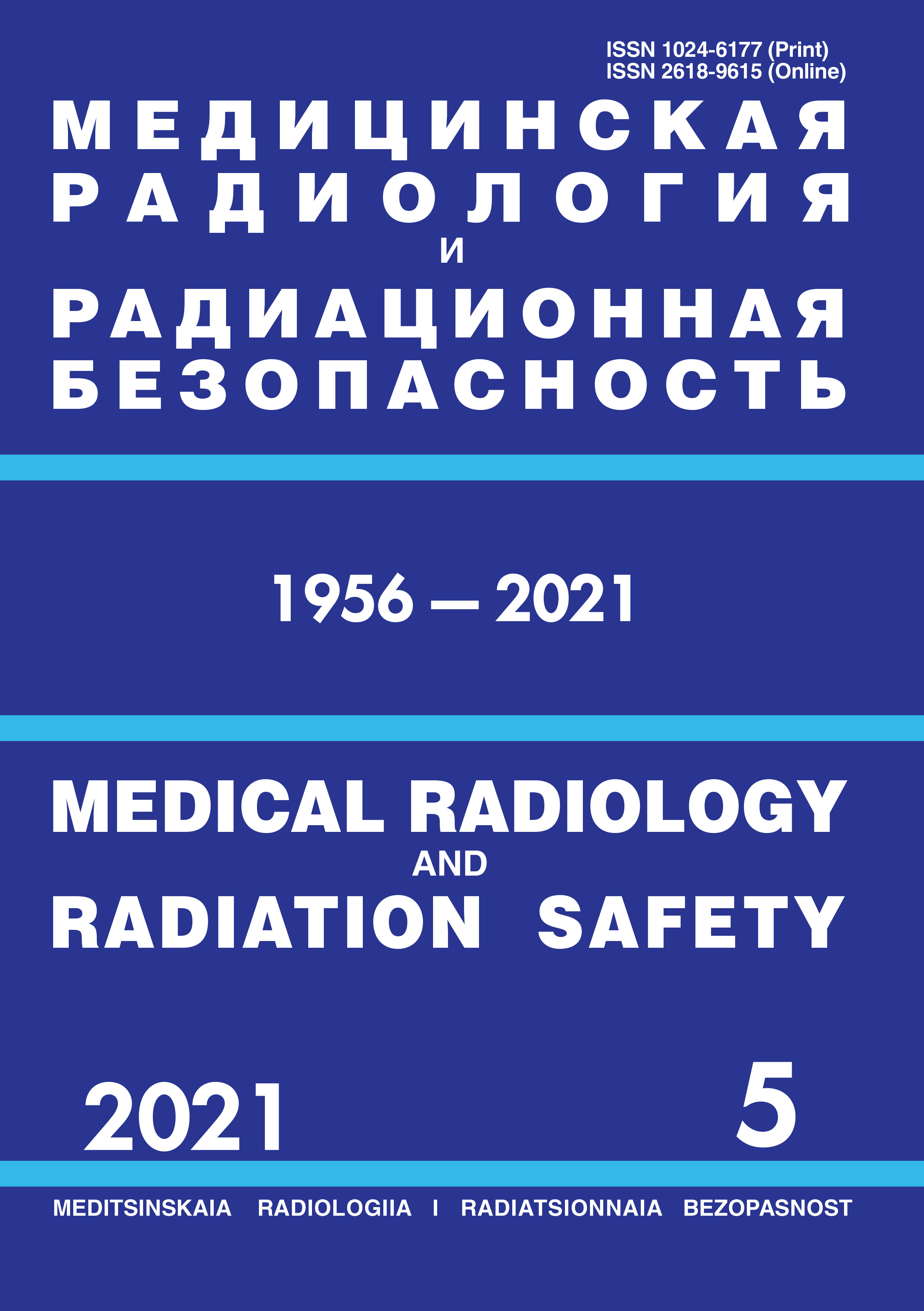Obninsk, Kaluga, Russian Federation
employee
GRNTI 76.33 Гигиена и эпидемиология
GRNTI 76.03 Медико-биологические дисциплины
OKSO 31.06.2001 Клиническая медицина
OKSO 31.08.08 Радиология
OKSO 32.08.12 Эпидемиология
OKSO 14.04.02 Ядерные физика и технологии
BBK 534 Общая диагностика
BBK 51 Социальная гигиена и организация здравоохранения. Гигиена. Эпидемиология
TBK 5712 Медицинская биология. Гистология
TBK 5734 Медицинская радиология и рентгенология
TBK 6212 Радиоактивные элементы и изотопы. Радиохимия
TBK 5708 Гигиена и санитария. Эпидемиология. Медицинская экология
Purpose: To analyze a number of immunohistochemical markers as predictors of the radiosensitivity of rectal adenocarcinoma. Material and methods: The study included 122 patients with histologically verified rectal adenocarcinoma, varying degrees of differentiation, and the stage of the tumor process I-IIIC, T2-T4b /N0-N2b/ M0, with the localization of the tumor in the lower-middle-ampullary parts of the rectum. Predictors included in the research: Ki67, p53, EGFR, Bcl2, COX2, P21, E-cadherin. Preoperative chemoradiotherapy was performed up to 48–50 Gy with the use of medications (5-FU, Cisplatin) as a radio modifiers. The analysis was carried out according to the degree of severity of therapeutic pathomorphosis (according to Mandard), a decrease in the stage before surgery. Results: A full course of preoperative chemoradiotherapy followed by surgery was performed at 121 patients, one patient died of concomitant cardiac pathology during the break. The first degree of Mandard pathomorphosis (complete resorption) registered at 12 patients. The second degree (preservation of a few tumor cells against the background of fibrotic changes) – at 27 patients. The third degree (a large number of preserved tumor cells against the background of the predominance of fibrosis) – at 38 patients. The fourth degree (tumor cells predominate over fibrotic changes) – at 27 patients. The fifth degree (complete absence of signs of tumor regression, absence of fibrosis) – at 2 patients. A decrease in the stage of the tumor process according to the preoperative comprehensive examination registered in 114 (94.2%) patients, in 9 (7.4%) patients – there was no dynamics. During the observation period from 2006 until nowadays, 10 people are known to have died. Years in remission range from 3 months to 22 years. According to the results of multivariate and multiple regression analyses, it is possible to successfully predict the effectiveness of chemoradiotherapy, both with the use of biomarkers (Ki67, p53, EGFR, Bcl2, COX2, P21, E-cadherin), and traditional indicators (histological type, stage of the disease, gender, degree of differentiation). It turned out, that both traditional indicators and immunohistochemical indicators work equally well, regardless of each other. Conclusion: Studied immunohistochemical predictors of radiosensitivity of rectal adenocarcinoma, allow to assess the degree of radiosensitivity or radioresistance of the tumor in each patient before the start of preoperative chemoradiotherapy by doing so, it warns us about the effectiveness or ineffectiveness of chemoradiotherapy in a specific clinical situation, which allows us to individualize the approach to treatment, choosing a more suitable treatment method for the patient: neoadjuvant chemotherapy or surgery.
locally advanced rectal cancer, preoperative chemoradiotherapy, therapeutic pathomorphosis, radiosensitivity predictors
1. Sidorov D.V., «Rol' total'noy mezorektumektomii v hirurgicheskom i kombinirovannom lechenii bol'nyh rakom pryamoy kishki». 2011. Diss. dokt. med. nauk: S.5.
2. Bailey C.E., Hu C.-Y., You Y.N., et al. 2015. Increasing disparities in the age-Related incidences of colon and rectal cancers in the United States, 1975-2010 // JAMA Surg, 2015 Jan. Vol. 150, No 1. P. 17-22. https://doi.org/10.1001/jamasurg.2014.1756
3. Kaprin A.D., Starinskiy V.V., Petrova G.V., Sostoyanie onkologicheskoy pomoschi naseleniyu Rossii v 2018 godu. 2019, s. 80.
4. Chernikovskiy I.L. Mul'tidisciplinarnyy podhod v diagnostike i lechenii rezektabel'nogo raka pryamoy kishki // Prakticheskaya onkologiya. 2015. T. 16, № 2. S. 69-76.
5. Rasulov A.O., «Hirurgicheskaya taktika posle himioluchevoy terapii raka pryamoy kishki». 2012. Diss. dokt. med. nauk:, s.5,6,7.
6. Chernichenko M.A., «Optimizaciya hirurgicheskogo i kombinirovannogo lecheniya bol'nyh nizhneampulyarnym rakom pryamoy kishki». 2016g. Diss. kand. med. nauk S.84, 121.
7. Giralt J, Eraso A, Armengol M, Rossello J, et al. Epidermal growth factor receptor of tumor response in locally advanced rectal cancer patients treated with preoperative radiotherapy // Int J Radiat Oncol Biol Phys. 2002. No 54. P. 1460-5. https://doi.org/10.1016 /s0360-3016(01)01842-9.
8. Rau B, Sturm I, Lage H, Berger S, Schneider U, Hauptmann S, et al. Dynamic expression profile of p21WAF1/CIP1 and Ki-67 predicts survival in rectal carcinoma treated with preoperative radiochemotherapy // J Clin Oncol. 2003. № 21. P. 3391-401. https://doi.org/10.1200/jco.2003.07.077.
9. Smith F.M., Reynolds J.V., Miller N., Stephens R.B., Kennedy M.J., 2005. Pathological and molecular predictors of the response of rectal cancer to neoadjuvant radiochemotherapy. European Journal of Surgical Oncology: the Journal of the European Society of Surgical Oncology and the British Association of Surgical Oncology, 01 Dec 2005, Vol. 32, No 1. P. 55-64. https://doi.org/https://doi.org/10.1016/j.ejso.2005.09.010
10. Negri FV 1, Campanini N, Camisa R, Pucci F, Bui S, Ceccon G, Martinelli R, Fumagalli M, Losardo PL, Crafa P, Bordi C, Cascinu S, Ardizzoni A. Biological predictive factors in rectal cancer treated with preoperative radiotherapy or radiochemotherapy. British Journal of Cancer, No 98. P. 143-147. 2008 Jan 15. https://doi.org/10.1038/sj.bjc.6604131.





